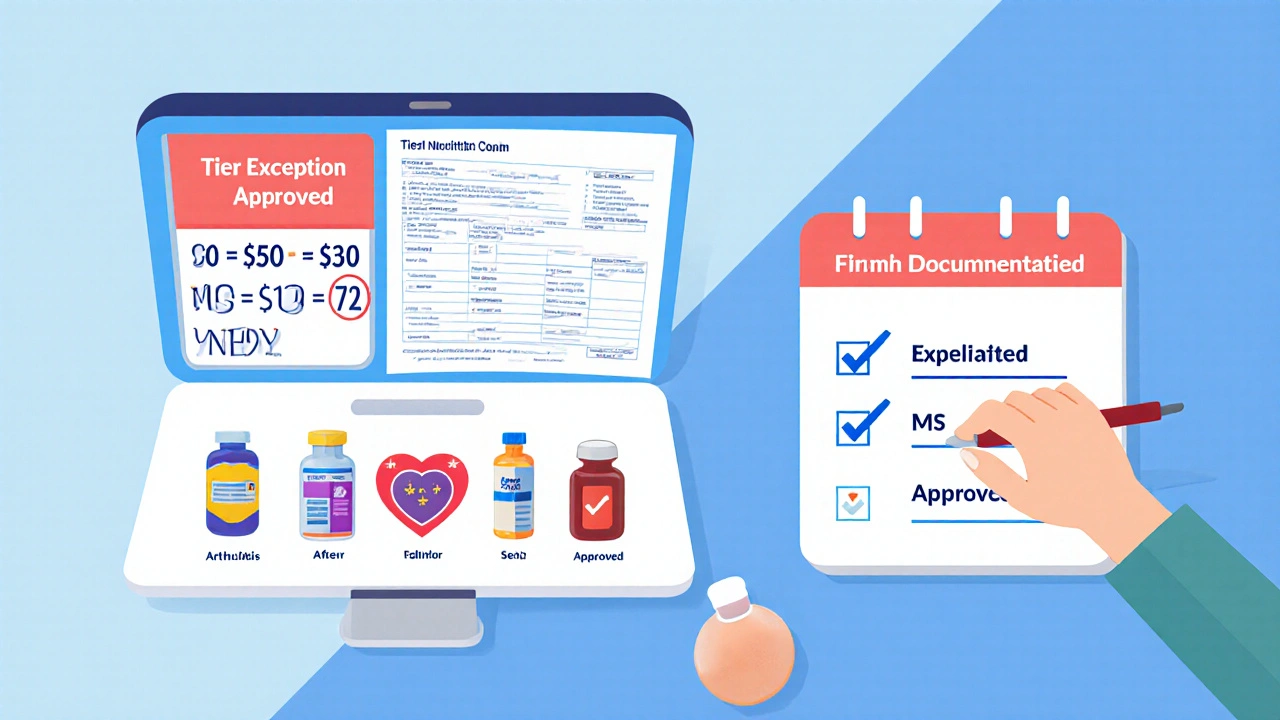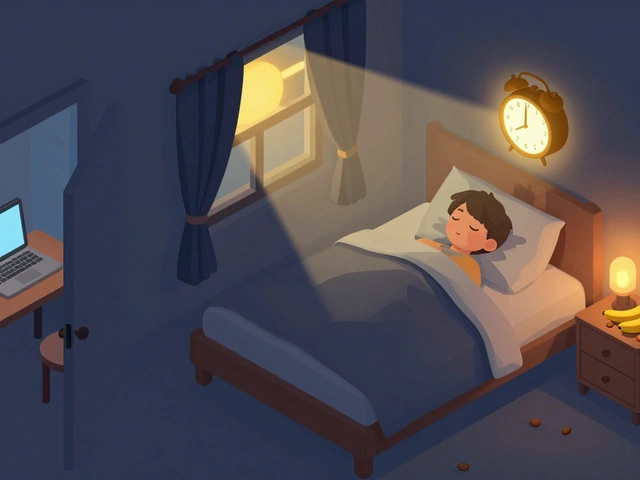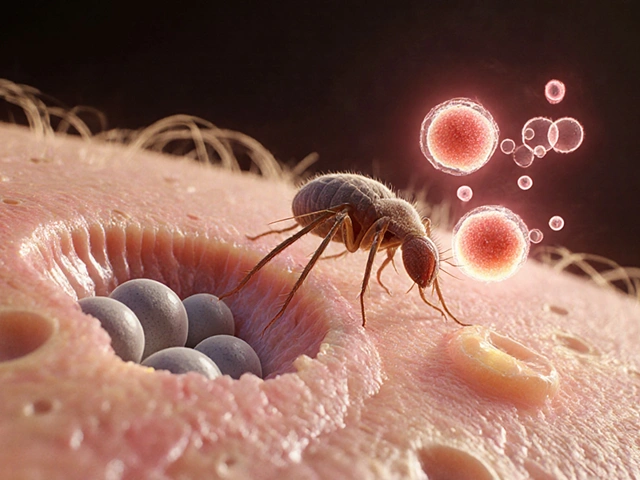How to Use Tier Exceptions to Lower Your Medication Copays

Imagine paying $150 a month for your arthritis medication - then finding out you could pay just $45 by asking for a simple change. That’s not a dream. It’s a tier exception - a tool built into your Medicare Part D plan that lets you pay less for a drug you already need.
What Is a Tier Exception?
Your prescription drug plan puts medications into tiers. Tier 1 is the cheapest - usually generics, with a $0 to $10 copay. Tier 2 is preferred brand-name drugs, maybe $15 to $30. Tier 3 is non-preferred brands, often $50 to $100. Tier 4 and 5? Those are specialty drugs - sometimes costing hundreds or even over $1,000 a month. A tier exception is your request to move a drug from a higher tier to a lower one - not because it’s better, but because it’s medically necessary for you. The drug might be on the formulary, but it’s stuck in the expensive tier. You’re not asking for a new drug. You’re asking for fair pricing. The Centers for Medicare & Medicaid Services (CMS) defines this clearly: it’s a coverage determination to get a non-preferred drug at the lower cost-sharing rate. It’s not a formulary exception - that’s for drugs not covered at all. This is about cost, not access.Why Do Tier Exceptions Work?
Insurance companies use tiers to push people toward cheaper drugs. They negotiate lower prices with manufacturers for drugs on preferred tiers. But not every patient responds the same way. A generic blood thinner might cause bleeding. A cheaper antidepressant might make you too drowsy to drive. That’s where tier exceptions come in. In 2023, Medicare Part D plans covered 48 million people. Nearly all of them - 92% - used tiered formularies. And yet, only 18% of eligible patients even tried to get a tier exception, according to Kaiser Family Foundation data. That means most people are overpaying without realizing it. Here’s the math: Moving a drug from Tier 4 ($150/month) to Tier 2 ($30/month) saves $1,440 a year. Moving from Tier 3 ($80/month) to Tier 1 ($10/month) saves $840. And if you’re in the coverage gap (donut hole), getting that drug down a tier can mean avoiding hundreds more in out-of-pocket costs.Who Can Request a Tier Exception?
You can ask. Your doctor can ask. Someone helping you with your care - like a family member or advocate - can ask too. But here’s the catch: the request must come with clinical documentation from your prescriber. The insurance company doesn’t care that you don’t like the side effects of the preferred drug. They care if the preferred drug would be less effective, cause adverse reactions, or if you’ve already tried it and failed. Your doctor needs to write a letter or fill out a form explaining:- Why the preferred drug won’t work for you
- What happened when you tried it (if you did)
- Why your current drug is medically necessary
How to Request a Tier Exception - Step by Step
Step 1: Check your copayWhen your pharmacy tells you your copay is higher than expected, don’t just pay it. Ask: “Is this drug on a higher tier? Can we request a tier exception?” Step 2: Talk to your doctor
Bring your prescription and the copay amount to your next appointment. Say: “I can’t afford this copay. Can you help me request a tier exception?” Most doctors have forms ready or know how to submit one electronically. Step 3: Submit the request
Your doctor’s office will usually submit the form - either online through the insurer’s portal, by fax, or by mail. You can also submit it yourself through your plan’s website or phone line, but without your doctor’s note, it won’t go anywhere. Step 4: Wait for a decision
Standard requests take up to 14 days. If your doctor says your health could be at risk without the drug - say, you’re on a drug for multiple sclerosis and skipping doses could cause a flare-up - you can request an expedited review. That cuts the wait to 72 hours. Step 5: If denied, appeal
About 37% of initial requests get denied - not because they’re invalid, but because the documentation was too vague. Don’t give up. Ask your doctor to add more detail: lab results, prior treatment failures, specialist notes. The approval rate jumps to 78% on appeal.

What Drugs Are Most Likely to Qualify?
Tier exceptions aren’t random. They’re most often approved for drugs treating chronic, complex conditions where alternatives aren’t safe or effective. Common examples:- Rheumatoid arthritis: Biologics like Humira, Enbrel, or Remicade - often stuck in Tier 4, but medically necessary when TNF inhibitors fail
- Multiple sclerosis: Drugs like Tysabri or Ocrevus - no oral alternatives work the same way
- Heart failure: Entresto - not always on preferred tier, but superior to ACE inhibitors in certain patients
- Diabetes: GLP-1 agonists like Ozempic or Trulicity - sometimes denied lower tier status even when metformin isn’t enough
- Anticoagulants: Apixaban or rivaroxaban - preferred over warfarin in patients with bleeding history
Real Stories: What Works - and What Doesn’t
On Reddit, a user named PharmaPatient87 got Humira moved from Tier 4 to Tier 3. Copay dropped from $150 to $45. Approval took 10 days. Their doctor included: “Patient developed anti-drug antibodies to Enbrel. Humira is the only effective alternative.” That’s perfect. Another user, SeniorCare2023, tried twice for Xarelto. First denial: “Doctor didn’t explain why warfarin was unsafe.” Second try: “Patient had two episodes of GI bleeding on warfarin. INR unstable despite weekly monitoring.” Approved - but only to Tier 2, not Tier 1. Still saved $30/month. The Medicare Rights Center surveyed 1,200 beneficiaries. 58% succeeded. Average savings: $37.50 per fill. But 63% of those who failed said the process was “too complicated.” The difference? The winners had detailed doctor letters. The losers had vague notes.Timing Matters - Do This Early
Don’t wait until you’ve filled your prescription three times. The best time to request a tier exception is before you pay the first time. Why? Because if you pay full price, you might already be counting that cost toward your out-of-pocket maximum. If you get approved later, you won’t get reimbursed for what you already paid. New trend: “Proactive tier exceptions.” Some doctors now submit the request at the same time they write the prescription. UnitedHealthcare’s automated pre-approval tool shows approval likelihood before submission - cutting approval time from 9 days to under 4.What’s Changing in 2025?
The Inflation Reduction Act caps out-of-pocket drug costs at $2,000 a year for Medicare Part D beneficiaries starting in 2025. That sounds great - and it is. But here’s the catch: that cap applies to the total you pay after all discounts and rebates. If you’re on a $1,000-a-month drug in Tier 5, you’re still paying 25% coinsurance - $250 a month. Even with the cap, you’ll hit it fast. A tier exception that drops that drug to Tier 3 ($100/month) means you pay $25 instead. That’s $2,700 saved a year - and you’re still under the cap. Tier exceptions won’t disappear. They’ll just become even more important as people try to stretch their $2,000 limit over multiple high-cost drugs.What to Do Next
If you’re paying more than $40 a month for a brand-name drug:- Check your plan’s formulary online. Find your drug’s tier.
- Look up the preferred alternatives. Are there cheaper options?
- If no alternatives work for you, ask your doctor: “Can we request a tier exception?”
- Don’t accept “we don’t do that” - it’s your right.
Frequently Asked Questions
Can I request a tier exception for any medication?
No. You can only request a tier exception for a drug that is already on your plan’s formulary but is placed in a higher cost-sharing tier than you want. You can’t use this to get a drug that’s completely excluded from coverage - that’s a formulary exception, which has different rules.
Does my doctor have to fill out a form?
Yes. Insurance companies require a written statement from your prescriber explaining why the preferred drug won’t work for you. This isn’t optional. Generic statements like “I prefer this drug” won’t be accepted. You need clinical reasoning: side effects, treatment failures, lab results, or specialist recommendations.
How long does a tier exception take to approve?
Standard requests take up to 14 days. If your doctor says your health could be harmed by waiting - for example, if you’re on a drug for epilepsy or heart failure - you can request an expedited review. That cuts the timeline to 72 hours. Most approvals happen within 10 days when the documentation is complete.
What if my tier exception is denied?
Don’t give up. About 37% of initial requests are denied due to incomplete documentation - not because the request is invalid. Ask your doctor to add more detail: specific side effects you experienced, prior drug failures, lab values, or specialist notes. When appealed with stronger evidence, approval rates jump to 78%.
Can I get reimbursed for copays I already paid?
Usually not. If you paid for your prescription before the tier exception was approved, you won’t get money back. That’s why it’s critical to request the exception before filling your first prescription. If you’ve already paid, you can still get the lower copay going forward - but past payments are not refunded.
Do all Medicare Part D plans offer tier exceptions?
Yes. All Medicare Part D plans are required by CMS to offer tier exceptions as part of their coverage determination process. This is not optional. If your plan says they don’t do it, they’re wrong. Contact Medicare.gov or the Medicare Rights Center for help.
Will tier exceptions still matter after the $2,000 cap in 2025?
Absolutely. The $2,000 cap applies to your total out-of-pocket spending, but it doesn’t change how your plan structures copays. If you’re on a $1,000 specialty drug, you might pay 25% coinsurance - $250 a month. That’s $3,000 a year. A tier exception that drops it to a $100 drug with a $30 copay saves you $2,700. Even with the cap, lower tiers mean you stretch your $2,000 further across multiple medications.
Next Steps
If you’re paying over $50 a month for a brand-name drug, take action now:- Log into your plan’s website. Find your drug’s tier.
- Compare it to the preferred alternatives.
- If none work for you, call your doctor’s office and ask to speak to the medical assistant or nurse. Say: “I need help submitting a tier exception for [drug name].”
- Keep a copy of your request and the approval letter.






Comments (14)
Sammy Williams
21 Nov 2025
Just got my Humira tier exception approved last month. Copay dropped from $140 to $40. My doc filled out the form in 5 minutes. No big deal. Do it.
Noah Fitzsimmons
22 Nov 2025
Oh wow, another ‘just ask your doctor’ miracle cure. Next you’ll tell me I can fix my mortgage by yelling at my bank teller. The system’s rigged. Your ‘tier exception’? A placebo for the gullible. They’ll approve it… then raise your premiums next year. Classic bait-and-switch. I’ve seen it. You think you’re winning. You’re not.
Eliza Oakes
24 Nov 2025
Wait, so you’re telling me I’m supposed to trust a doctor who’s probably getting kickbacks from Big Pharma to push the expensive drug? I’ve got a cousin who got denied a tier exception for metformin because ‘it wasn’t medically necessary’ - but her $800 insulin was approved immediately. Hmm. Coincidence? I think not. This is all a scam to keep seniors broke.
David vaughan
25 Nov 2025
Just did this for my Eliquis… took 11 days. Doc included my INR logs, my fall history, and the ER visit from last year. Approved. Saved $110/month. You’re right - it’s not hard. Just… do the paperwork. Don’t be lazy. Seriously. It’s not that complicated. 😊
Steve Harris
25 Nov 2025
There’s a reason this works: Medicare Part D is designed to give patients leverage. The tiers are negotiated between insurers and pharma - not based on clinical value, but on rebates and volume discounts. A tier exception forces them to acknowledge that ‘cheaper’ doesn’t mean ‘better.’ If your doctor documents properly, you’re not asking for special treatment - you’re enforcing your rights under CMS guidelines. This isn’t a loophole. It’s a feature.
Logan Romine
27 Nov 2025
They say ‘ask for a tier exception’ like it’s a prayer you whisper to the gods of insurance. But what if your doctor doesn’t care? What if they’re burnt out? What if they don’t even know how to submit the form? The system doesn’t care if you’re drowning in debt - it only cares if the paperwork has a signature. And if you’re elderly, disabled, or alone? Good luck. This isn’t empowerment. It’s a bureaucratic obstacle course with a shiny sticker that says ‘You Can Win!’
Chris Vere
29 Nov 2025
Interesting how the system works. In Nigeria, we just pay out of pocket or go without. No tiers. No forms. Just survival. But here, people fight over copays like it’s a sport. I admire the persistence. But also… isn’t it sad that you have to be this strategic just to afford medicine? The real problem isn’t the tier. It’s the price.
Simone Wood
30 Nov 2025
My sister got denied twice for her MS drug. First time: ‘insufficient documentation.’ Second time: ‘preferred alternative is available.’ But the ‘preferred’ one gave her seizures. Her neurologist finally wrote: ‘Patient experienced grade 3 CNS toxicity on fingolimod. Ocrevus is the only viable option.’ Approved on third try. Took 6 weeks. She missed two work weeks. No one thanked her. No one even asked how she was. Just ‘submit the form.’
Sandi Moon
30 Nov 2025
Let’s be clear: this entire tier exception framework is a marketing ploy by insurers to make you feel like you have agency. In reality, they approve only what’s profitable. The 78% appeal success rate? That’s because they’re forced to by regulators. But they’ll still hike your premiums next year. And they’ll still deny the next drug you need. This isn’t justice. It’s theater.
Kartik Singhal
2 Dec 2025
Bro… I just got Ozempic approved on Tier 2 after 3 rejections. Doc sent my HbA1c, my weight loss logs, and a video of me crying in the pharmacy because I couldn’t afford my insulin. They approved it. 😭💸 I’m not crying because I’m poor. I’m crying because this is normal now. Welcome to America, where your life depends on your doctor’s typing speed.
Sheldon Bazinga
3 Dec 2025
Oh wow, another ‘just get your doctor to write a letter’ solution. Meanwhile, the same people who wrote this post are probably on the board of some PBMs. You think this is about fairness? Nah. It’s about making you think you’re doing something while they keep raking in billions. You’re not a patient. You’re a revenue stream with a copay.
Cooper Long
4 Dec 2025
While the procedural framework described is accurate, one must not overlook the systemic asymmetry of power inherent in the physician-payer dynamic. The burden of advocacy falls disproportionately upon the patient, whose clinical literacy is often limited, while the insurer maintains proprietary algorithms determining formulary placement. The tier exception, though formally permissible, remains a contingent privilege rather than a guaranteed right.
Pravin Manani
5 Dec 2025
I’ve helped 12 seniors file tier exceptions this year. Most don’t know their plan’s formulary exists. Some think ‘copay’ means ‘what the pharmacy says.’ I sit with them. I call the pharmacy. I help the doc fill out the form. One woman saved $900/year. She cried. I cried. This isn’t magic. It’s just… human work. Someone has to do it. Why not you?
Noah Fitzsimmons
5 Dec 2025
Wait, so you actually believe the insurance company gives a damn about your ‘medical necessity’? They’re not doctors. They’re accountants with a clipboard and a 10-page denial template. They don’t care if you bleed. They care if you’re on the list. And if you’re not? You’re just a statistic. Don’t waste your breath. Just get a side job.